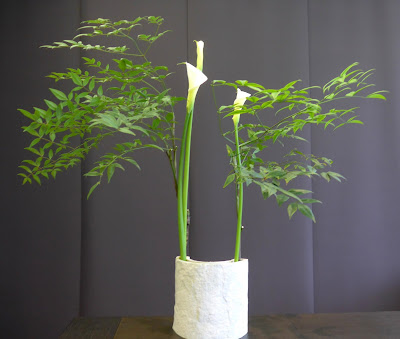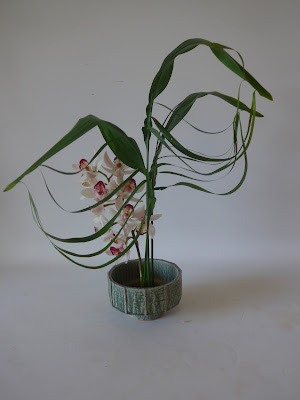Hello all,
For the above arrangement I am indebted to my student Shaneen Garbutt, who provided these stunning flowers and leaves. I channeled our Theresa Faile, who has recently passed away and, who was the foremost authority on the rules for arranging flag irises. Theresa was trained by Norman Sparnon and was called on, time and time again, to demonstrate this arrangement. In my demonstration, I hope I did it justice.
For the above arrangement I am indebted to my student Shaneen Garbutt, who provided these stunning flowers and leaves. I channeled our Theresa Faile, who has recently passed away and, who was the foremost authority on the rules for arranging flag irises. Theresa was trained by Norman Sparnon and was called on, time and time again, to demonstrate this arrangement. In my demonstration, I hope I did it justice.
For class last week for the senior students, I went back
to the old Book 4 for inspiration. I set the theme, which is no longer included
in our current curriculum, 'Arrangement using wood, without container'.
Basically, it means creating a sculptural piece using woody branch materials,
which stands alone.
Again, only Lucy and Vicky were present for class as there were a number of absentees. Below is Vicky's piece, before an after fresh materials.
 |
| Vicky used corky elm |
 |
| The little container is not resting on the table but is held up by the branches. |
As for me, I used some lichen covered elm branches for my first piece. I then added yellow flag iris stems, curtesy of Shaneen. They pick up some of the yellow lichen, which unfortunately, doesn't show in the photo.
 |
For my second piece I used a number of wisteria vines, which I joined to create this tall (1.8 m) piece. The gymea leaves work well here as they don't need water.
The three photographs, below, are of my arrangement 'To be viewed from all sides'. I used strelitzias, viburnunum opulus, calla lily spadix (the little yellow bit inside the lilly), gymea leaves and strelitzia nicolai leaf.
I leave you with this wall arrangement with the theme 'A variety of materials' (six in this case).








































